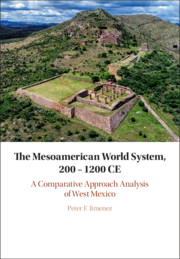Book contents
- The Mesoamerican World System, 200–1200 CE
- The Mesoamerican World System, 200–1200 CE
- Copyright page
- Dedication
- Contents
- Figures
- Tables
- Acknowledgments
- Abbreviations
- Chapter One West Mexico Coalesced
- Chapter Two The Comparative World-Systems Approach and Its Application to Archaeology
- Chapter Third The Regional Setting of West Mexico at 200 CE
- Chapter Four The Late Formative–Early Classic Period Transition 200/250–550 CE
- Chapter Five World-System Decentralization
- Chapter Six The Early Postclassic Period Transformation of West Mexico 900–1200 CE
- Chapter Seven West Mexico in the Mesoamerican World System
- References
- Index
Chapter Seven - West Mexico in the Mesoamerican World System
Published online by Cambridge University Press: 10 August 2020
- The Mesoamerican World System, 200–1200 CE
- The Mesoamerican World System, 200–1200 CE
- Copyright page
- Dedication
- Contents
- Figures
- Tables
- Acknowledgments
- Abbreviations
- Chapter One West Mexico Coalesced
- Chapter Two The Comparative World-Systems Approach and Its Application to Archaeology
- Chapter Third The Regional Setting of West Mexico at 200 CE
- Chapter Four The Late Formative–Early Classic Period Transition 200/250–550 CE
- Chapter Five World-System Decentralization
- Chapter Six The Early Postclassic Period Transformation of West Mexico 900–1200 CE
- Chapter Seven West Mexico in the Mesoamerican World System
- References
- Index
Summary
This study posed a question: Are core–periphery relations and the changes brought about by these interactions perceivable in the archaeological record? To address this, the world-systems analytical framework of the comparative approach (Chase-Dunn and Hall 1997) was operationalized for two reasons: First, the approach represents a significant refinement of the definition of core–periphery relations in precapitalist settings through the discernment of four networks (i.e., bulk goods, political/military, prestige goods, and information). This refinement, initially applied by Chase-Dunn and Hall (1997: 121–233) in case studies utilizing principally historical and ethnohistorical data, made its use as an analytical lens to an archaeological setting as a material culture model relevant to evaluate its usefulness in ancient world-systems analysis (WSA). The proposed core–periphery relations between West and Central Mexico represented a unique spatiotemporal setting to operationalize this approach. Chase-Dunn and Hall (1997: 17) underline that to examine social processes over broad areas in WSA, it is essential to focus first on the definition of the structural patterns of world systems. That first step has been undertaken in this book.
- Type
- Chapter
- Information
- The Mesoamerican World System, 200–1200 CEA Comparative Approach Analysis of West Mexico, pp. 174 - 188Publisher: Cambridge University PressPrint publication year: 2020



